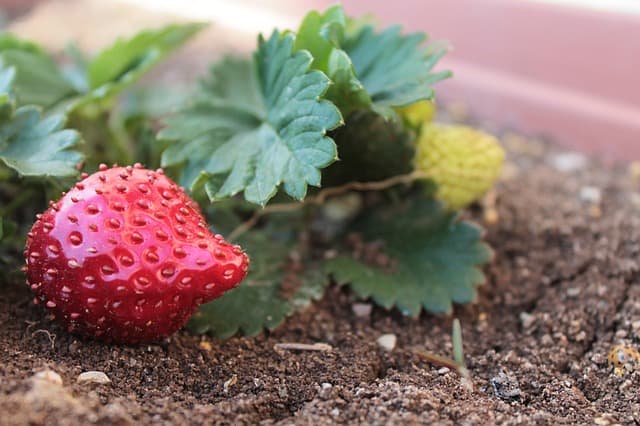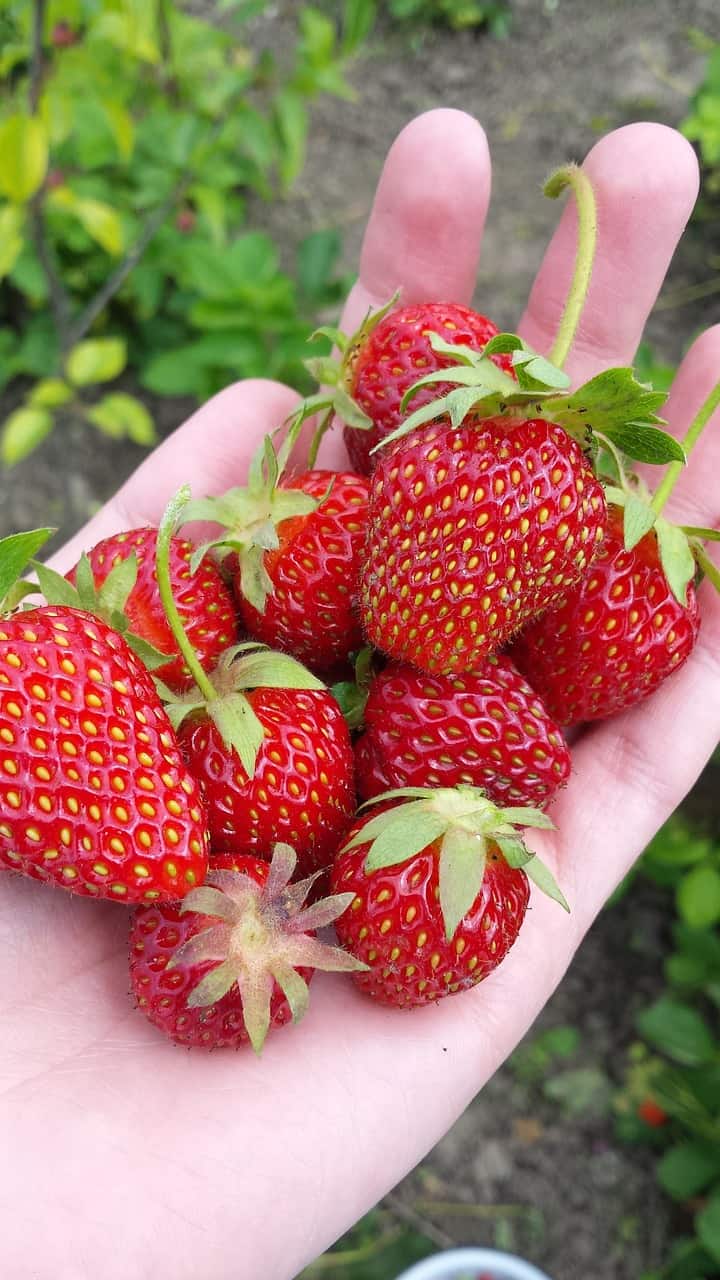Discover how to grow strawberries indoors and enjoy fresh berries throughout the year. Indoor cultivation empowers you to create optimal growing conditions for your strawberry plants. This guide is convenient for those with limited outdoor space or who prefer having strawberries within easy reach at home.
Growing strawberries inside is a straightforward process, and with the proper care, you can relish a generous harvest of juicy, sweet berries. Strawberry plants thrive indoors with everbearing and day-neutral varieties, which are particularly suited for container or pot cultivation and perfect for small spaces. Moreover, an indoor setup shields your strawberry plants from common outdoor pests and diseases.

Choosing the Right Strawberry Varieties
The journey of whether strawberries can be grown indoors is indeed fulfilling, but it’s crucial to pick a variety that adapts well to your indoor conditions. Among the different types, June-bearing, day-neutral, and everbearing strawberries, along with several cultivars, are excellent for indoor cultivation.
Understanding June-Bearing, Day-Neutral, and Everbearing Varieties
The strawberry plant known as June-bearing produces fruit primarily in June and is recognized for a substantial harvest over a few weeks. Conversely, day-neutral strawberries offer fruit consistently throughout the growing season, while everbearing strawberries yield twice annually and are particularly well-suited for indoor cultivation.
Selecting Strawberry Cultivars for Indoor Growth
For an indoor strawberry plant, choosing varieties that thrive indoors is vital. Popular choices like Tristar, Seascape, and Quinault are celebrated for their compact growth and abundant yield in indoor settings.
When considering strawberries inside your home, looking at the strawberry type is essential. Alpine strawberries are an excellent indoor variety, producing small yet flavorful berries ideal for a quick, healthy snack.
In summary, can strawberry plants grow indoors? Absolutely, but it’s critical to select the right type and cultivar of strawberry for indoor cultivation. You can enjoy a bountiful supply of delicious berries from your indoor strawberry plants by choosing appropriately.
Creating the Ideal Indoor Environment
I was wondering if you can grow strawberries indoors. It’s possible and can be a delightful way to have fresh, juicy berries throughout the year. However, creating the ideal indoor environment is crucial for the success of your strawberry plants. This section will explore the key factors to consider when setting up your indoor strawberry garden.
Light and Temperature Requirements
Strawberry light requirements indoors dictate that strawberry plants need at least 6 hours of direct sunlight or 12 hours under an LED plant light daily. Place your plants near a sunny window or beneath a grow light to ensure they receive enough light. The ideal temperature for growing strawberries indoors is between 60-80°F (15-27°C). It’s essential to avoid placing your plants near drafty windows or in areas with extreme temperature fluctuations.
Soil and Container Selection
Growing strawberries in pots requires selecting well-draining potting soil and a container at least 6 inches deep. Good drainage is essential to prevent waterlogged soil, which can cause root rot. Use a container with drainage holes and add a layer of pebbles or gravel at the bottom to improve drainage further.
Watering and Humidity Control
Strawberry plant indoor care includes consistent watering to keep the soil moist but not soggy. Daily, check the soil surface and water when it feels dry to the touch. It’s essential to avoid getting water on the leaves or crowns of the plants, as this can promote disease. To maintain proper humidity levels, place a tray of water near your plants or use a humidifier to ensure good air circulation to prevent mold and mildew growth.
Following these tips to grow strawberries inside and create the ideal indoor environment, you can ensure your strawberry plants thrive and produce delicious berries.
Planting and Caring for Your Indoor Strawberries
Growing strawberries indoors can be a fun and rewarding experience. You can enjoy fresh strawberries year-round with the proper techniques and care, such as learning how to grow strawberries in pots. This section will cover some essential tips for planting and caring for your indoor strawberries.
Planting Techniques and Timing
Choosing a suitable indoor strawberry planter and potting mix is essential when planting strawberries indoors. Strawberry pots or containers with drainage holes are ideal. A potting mix that includes peat moss, compost, and perlite will support healthy growth. It is crucial to avoid overwatering the plants as it can lead to root rot.
Wondering, ‘Can I grow strawberries indoors’? The optimal time to sow strawberry seeds is early spring or late fall. Planting bare-root strawberry plants is also feasible in late winter or early spring. These plants should bask in at least six hours of sunlight daily to flourish. If the natural light is lacking, consider using a grow light to boost the light levels.
Fertilization and Nutrient Management
For those asking, ‘Can strawberries grow indoors?’ Fermentation is a critical factor for the robust growth of indoor strawberries. Employ a balanced fertilizer rich in nitrogen, phosphorus, and potassium. Adhering to the manufacturer’s guidelines for fertilizer application is vital to avoid over-fertilizing, which can cause nutrient burn and harm to your plants.
When pondering ‘Can I grow strawberries inside,’ remember that nutrient management in the potting mix is vital. Enriching the potting mix with compost or organic matter can enhance soil fertility. Monitoring the soil pH levels is crucial, aiming for a sweet spot between 5.5 and 6.5 for growing strawberries.
Pest and Disease Prevention
A strawberry plant indoors may encounter pests like spider mites, thrips, and aphids. To ward off these pests, maintain plant cleanliness and health. Regular pest inspections and prompt control measures are essential to protect indoor strawberries.
Indoor strawberries may fall prey to diseases like root rot and powdery mildew. To keep such issues at bay, ‘can strawberries grow inside’ enthusiasts should ensure their plants get plenty of sunlight and airflow. Prevent overwatering and use a well-draining potting mix. Should disease symptoms appear, isolate the affected plant promptly to halt the spread.
By adhering to these guidelines for planting and nurturing indoor strawberries, you can savor fresh strawberries all year. With diligent care, ‘can you grow strawberries inside’ becomes a reality, leading to a plentiful harvest of your indoor strawberries.

Harvesting and Enjoying Your Strawberries
After the anticipation of watching your homegrown strawberries reach maturity, it’s harvest time. Here are some pointers for picking and relishing strawberries from your strawberry plant.
Knowing When to Pick Strawberries
Ripe strawberries from a healthy strawberry plant are plump and red and have a sweet aroma. They should be harvested when entirely red but not overly soft. It is ideal to pick strawberries in the morning when they are still cool from the night’s air. The yield of these fruiting crops will depend on the strawberry plant variety and the specific growing conditions.
It is essential to pick strawberries carefully to avoid damaging the plant. Hold the stem of the strawberry and gently twist it to remove it from the plant. If the strawberry is too soft or firm, it may not be ripe enough or overripe.
Storing and Preserving Your Harvest
Once you have picked your strawberries, it is essential to store them properly to preserve their flavor and texture. Homegrown strawberries are usually softer and sweeter than store-bought ones, so it is best to use them within a few days of picking.
If you have more strawberries than you can eat in a few days, consider how long it takes to grow strawberries indoors, as you can freeze them for later use. To freeze strawberries, wash and dry them thoroughly, remove the stems, and place them in a single layer on a baking sheet. After freezing the strawberries for a few hours, transfer them to a freezer-safe container or bag. These frozen strawberries can be used for making strawberry shortcakes, smoothies, or even ice cream.
In conclusion, with the right conditions, can you grow strawberries indoors all year round? Doing so can provide a year-round supply of sweet and delicious fruit. With proper care and attention, you can enjoy the taste of fresh strawberries from the comfort of your home.
Frequently Asked Questions
What is the process for growing strawberries from seeds inside?
Growing strawberries from seeds indoors is more challenging than growing them from established plants. You will need to start by purchasing high-quality seeds, and then you will need to plant them in a container with a good potting mix. Keep the soil moist and provide plenty of light. Once the seedlings have sprouted, you can transplant them into individual pots and continue to care for them until they are mature enough to produce fruit.
Can strawberries be cultivated indoors using fruit as a starting point?
Yes, it is possible to start growing strawberries indoors using fruit. You can purchase organic strawberries from your local grocery store and remove the seeds from the fruit. Then, you can plant the seeds in a container with a good potting mix and follow the same process as you would with seeds.
Is it possible to maintain strawberry growth indoors throughout the year?
With the proper setup, you can maintain strawberry growth indoors throughout the year, a method known as indoor strawberry hydroponics. This approach requires adequate lighting and temperature control to simulate the outdoor environment, facilitating year-round growth and easier maintenance.
What type of lighting is required for indoor strawberry cultivation?
For optimal fruit production, strawberries need at least 6 to 8 hours of direct sunlight daily. If natural light is insufficient in your indoor space, supplement it with artificial grow lights, such as fluorescent or LED lights. Ensure that these grow lights are positioned close to the strawberry plants and adjust their height as they grow.
What is the typical timeframe for harvesting strawberries grown indoors?
The timeframe for harvesting strawberries indoors can vary depending on the variety of strawberries and the growing conditions. Generally, it takes 4 to 6 weeks for the plants to produce fruit after flowering. Once the fruit has ripened, it can be harvested and enjoyed.
How do you effectively pollinate strawberries when growing them indoors?
When growing strawberries under lights indoors, the plants may require manual pollination to ensure successful fruit production. You can use a small paintbrush or cotton swab to transfer pollen from the stamen to the pistil of each flower or gently shake the plants to release the pollen. It’s essential to pollinate each flower individually for the best results.

